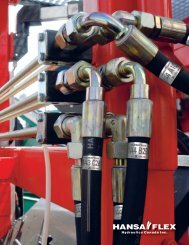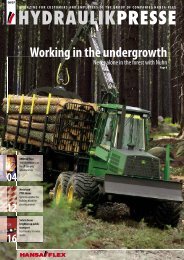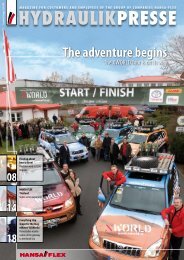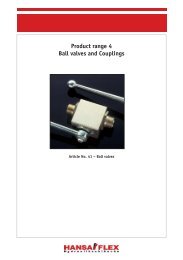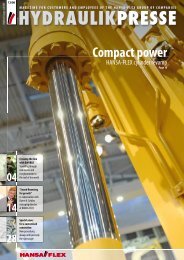hydraulik - HANSA-FLEX Hydraulics Canada Inc.
hydraulik - HANSA-FLEX Hydraulics Canada Inc.
hydraulik - HANSA-FLEX Hydraulics Canada Inc.
Create successful ePaper yourself
Turn your PDF publications into a flip-book with our unique Google optimized e-Paper software.
������������������������������������������������������������������������<br />
HYDRAULIKPRESSE<br />
OFFSHORE ENGINEERING<br />
Electricity generation from offshore wind turbines<br />
may well play a major role in Germany’s future energy<br />
and climate control policy. The advantage of<br />
offshore installations is that the wind blows more<br />
strongly (at much higher speeds) and more continuously.<br />
The offshore wind parks spreading across wide<br />
areas of our coastal waters have enormous potential<br />
to generate energy.<br />
In order to work really productively, offshore wind<br />
parks should be situated well away from the coast.<br />
This means the technical demands placed on offshore<br />
installations in terms of tower construction,<br />
cable laying and servicing are correspondingly<br />
high. They not only have to withstand the wind and<br />
waves, they also have to be highly technically reliable,<br />
so as to ensure low-maintenance, trouble-free<br />
subsequent operation. Any servicing of the wind<br />
park carried out at sea costs money, and has to be<br />
done by service technicians shipped out specially.<br />
The gigantic offshore wind parks operated by the<br />
Bremerhaven-based Multibrid GmbH essentially<br />
consist of a foundation, a tubular steel tower and<br />
08<br />
A new dimension in offshore wind turbines<br />
Heading out to sea<br />
HYDRAULIKPRESSE<br />
the gondola – which is in effect the engine room,<br />
housing the generator and a 116-meter diameter<br />
rotor.<br />
Multibrid specialises in the production of highperformance<br />
five-megawatt offshore wind turbines.<br />
Highly-qualified specialists work together<br />
with component suppliers to ensure the ongoing<br />
development of Multibrid technology. Multibrid’s<br />
M5000 is the world’s first wind turbine designed<br />
exclusively for large-scale offshore parks. Its design<br />
enables it to be quickly and easily installed on-site.<br />
The only assembly work is to join together the<br />
tower, gondola and rotor; all the other components<br />
come pre-assembled and ready to run. Concerted<br />
development efforts have resulted in technical solutions<br />
which set new standards and are optimally<br />
attuned to conditions at sea.<br />
Sea water-resistant materials and compact gondola<br />
design are key. Like the rotor, the gondola is<br />
designed to be light-weight, so as to aid transport<br />
and installation. This is vital, because of course all<br />
the components – and the equipment needed to<br />
assemble and install them – must be dragged on<br />
pontoons by ocean-going tugs to the park location.<br />
Large floating cranes swing the components<br />
into position, constantly buffered by the wind and<br />
waves.<br />
Salty air must be kept out<br />
To meet the special needs of the offshore environment,<br />
the Multibrid M5000 features a hermetically<br />
sealed encapsulation to provide the systems<br />
with permanent protection against corrosive sea<br />
spray. That is a vital factor determining durability<br />
of components and systems at sea. The encapsulation<br />
process prevents any penetration of ambient<br />
air into the gondola or hub of the wind turbine.<br />
An air conditioning system mounted to the base of<br />
the tower filters the ambient air as it is drawn in<br />
and separates off water and salt particles. The conditioned<br />
air generates a pressure in the tower and<br />
gondola which ensures it passes through the plant<br />
ISSUE AUGUST 2008



